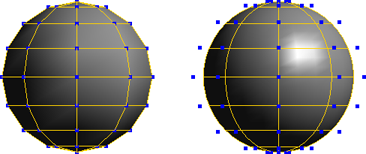The first step to creating a cloth object is to start with the right geometry and resolution. This has a big impact on the way that the cloth is deformed.
You can use either a NURBS surface or polygon object to be used as the cloth. You can also create a net of grids and assemble them into a NURBS surface mesh model, then use the resulting model as the cloth model.
You'll find that using polygon objects give a more accurate response to collisions because the points lie directly on the surface of the polygon, as compared to points on NURBS surfaces (see Data Exchange for more information on object geometry).

On the left, a polygon mesh sphere has points directly on its surface.
On the right, a NURBS surface sphere has its points away from the surface.
For example, if you're dragging a cloth over another object, the points of the cloth (as opposed to the cloth itself) ride over the other object. This may cause the cloth to go "into" the other object. With NURBS surfaces, you may have to adjust the Push Length parameter in the Obstacle Property Editor [Properties Reference] to keep the cloth surface from intersecting with the obstacle.
If you're using a polygon object as the cloth, keep a fairly constant polygon density and distribution. This is because every edge becomes a spring in the simulation, with additional invisible cross-bracing springs added to keep polygons from shearing.
If you want to build a garment, set up the appropriate parent-children hierarchy in the cloth model.
Make sure that the cloth model has a high enough resolution to give the effect you want. For example, if you want silk draped over a chair, the resolution needs to be higher than a piece of burlap. However, high-resolution objects are costly to calculate.
Generally, the cloth model must not be too low for two reasons:
You need a sufficient number of vertices for getting a satisfactory collision response. Edges may penetrate some polygons of the obstacle even if the vertices are well managed.
Subdivision not only adds new vertices but also moves the original ones, so you may violate the obstacle constraints.
As with all simulations, the trick is to find the lowest resolution acceptable for the results you want. One way to accomplish this is to use an acceptable low-resolution "stand in" model while you're setting up the basic simulation and collisions. Then when you're done that, swap in the high-resolution model and tune the parameters accordingly.
 Except where otherwise noted, this work is licensed under a Creative Commons Attribution-NonCommercial-ShareAlike 3.0 Unported License
Except where otherwise noted, this work is licensed under a Creative Commons Attribution-NonCommercial-ShareAlike 3.0 Unported License